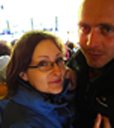






Antigua Guatemala or referred to just as Antigua:
From Copan in Honduras, we headed off to Antigua just before the beginning of the Holy Week. We skipped Guatemala City (as we did for the last capital cities) because of their similarities (except probably Panama City). San Jose and San Salvador were two examples.
Antigua, or as it was called in the past as "Santiago de los Cabelleros" was founded in 1543 by the Spaniards and became the capital of the Spanish Colony of Guatemala. In 1717 and 1773, the town was hit by earthquakes, making the Spanish to move the capital to a new town, Nueva Guatemala de la Asuncion or Guatemala City. The badly damaged city of Antigua was left quite abandoned with vestiges of the colonial architecture. It was slowly rebuilt retaining much of its colonial character.
We spent 5 days in Antigua, walking in the paved streets and visiting the colonial church ruins all over the town. We climbed the active Pacaya volcano. We saw some lava but far from us (some guys in the hostel told us there was lava everywhere when they went to climb the volcano!) but very nice sunset. We attended 2 processions, the "Viernes de Dolores" or "Friday of Pains" and the "Domingo de Ramos" or "Palm Sunday". Then we left Antigua for Panajachel close to the Atitlan Lake.
- Facing the main plaza, the Palacio de los Capitanes. From 1558 to 1773, this Palace was the governmental center of all Central America, from Chiapas (now in Mexico) to Costa Rica. The arcades were added in the 1760s. When we went to Antigua, the Palacio was under renovation,
- Also situated in one side of the main plaza, the cathedral de Santiago. This cathedral was founded in 1542, was badly damaged by earthquakes and thieves and was partially restored between 1780 and 1820. Lots of facade works were on-going when we arrived in Antigua, surely to show a more presentable face of the cathedral for the Holy Week celebrations!
- The famous Santa Catalina Arch. Part of the Monastery of Santa Catalina, it was built in the early 17th Century to allow the sisters to pass from one side of the Monastery to the other one. Earthquakes destroyed the Monastery and the Arch is the only remnant,
- Facade of the La Merced Church. The construction started in 1548 with more improvements after the earthquakes of 1717 and 1773. The church was restored end of the 19th Century and the baroque facade is coming from this period,
- Inside the ruins of the Monastery of La Merced, we were amazed by this superb fountain 27m of diameter, possibly the largest in Central America!
- One of the multiples ruins of churches which can be seen around Antigua. Can't remember the name of this one, sorry!
- Typical streets of Antigua with ground floor colored houses.


No comments:
Post a Comment